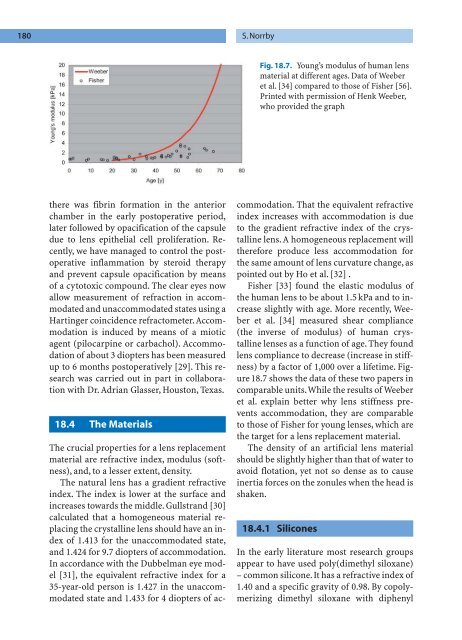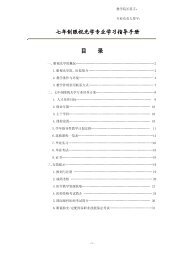Refractive Lens Surgery
Refractive Lens Surgery
Refractive Lens Surgery
Create successful ePaper yourself
Turn your PDF publications into a flip-book with our unique Google optimized e-Paper software.
180 S. Norrby<br />
there was fibrin formation in the anterior<br />
chamber in the early postoperative period,<br />
later followed by opacification of the capsule<br />
due to lens epithelial cell proliferation. Recently,<br />
we have managed to control the postoperative<br />
inflammation by steroid therapy<br />
and prevent capsule opacification by means<br />
of a cytotoxic compound. The clear eyes now<br />
allow measurement of refraction in accommodated<br />
and unaccommodated states using a<br />
Hartinger coincidence refractometer.Accommodation<br />
is induced by means of a miotic<br />
agent (pilocarpine or carbachol). Accommodation<br />
of about 3 diopters has been measured<br />
up to 6 months postoperatively [29]. This research<br />
was carried out in part in collaboration<br />
with Dr. Adrian Glasser, Houston, Texas.<br />
18.4 The Materials<br />
The crucial properties for a lens replacement<br />
material are refractive index, modulus (softness),<br />
and, to a lesser extent, density.<br />
The natural lens has a gradient refractive<br />
index. The index is lower at the surface and<br />
increases towards the middle. Gullstrand [30]<br />
calculated that a homogeneous material replacing<br />
the crystalline lens should have an index<br />
of 1.413 for the unaccommodated state,<br />
and 1.424 for 9.7 diopters of accommodation.<br />
In accordance with the Dubbelman eye model<br />
[31], the equivalent refractive index for a<br />
35-year-old person is 1.427 in the unaccommodated<br />
state and 1.433 for 4 diopters of ac-<br />
Fig. 18.7. Young’s modulus of human lens<br />
material at different ages. Data of Weeber<br />
et al. [34] compared to those of Fisher [56].<br />
Printed with permission of Henk Weeber,<br />
who provided the graph<br />
commodation. That the equivalent refractive<br />
index increases with accommodation is due<br />
to the gradient refractive index of the crystalline<br />
lens.A homogeneous replacement will<br />
therefore produce less accommodation for<br />
the same amount of lens curvature change, as<br />
pointed out by Ho et al. [32] .<br />
Fisher [33] found the elastic modulus of<br />
the human lens to be about 1.5 kPa and to increase<br />
slightly with age. More recently, Weeber<br />
et al. [34] measured shear compliance<br />
(the inverse of modulus) of human crystalline<br />
lenses as a function of age. They found<br />
lens compliance to decrease (increase in stiffness)<br />
by a factor of 1,000 over a lifetime. Figure<br />
18.7 shows the data of these two papers in<br />
comparable units.While the results of Weeber<br />
et al. explain better why lens stiffness prevents<br />
accommodation, they are comparable<br />
to those of Fisher for young lenses, which are<br />
the target for a lens replacement material.<br />
The density of an artificial lens material<br />
should be slightly higher than that of water to<br />
avoid flotation, yet not so dense as to cause<br />
inertia forces on the zonules when the head is<br />
shaken.<br />
18.4.1 Silicones<br />
In the early literature most research groups<br />
appear to have used poly(dimethyl siloxane)<br />
– common silicone. It has a refractive index of<br />
1.40 and a specific gravity of 0.98. By copolymerizing<br />
dimethyl siloxane with diphenyl



